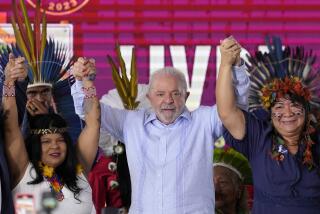Capital Outflow Limits Don’t Work
- Share via
During last week’s International Monetary Fund-World Bank meetings, the mood was decisively somber. Among participants from the emerging markets, there was a clear sense of anger and betrayal. They had been promised that market-oriented reforms, hard work and early sacrifices would be rewarded with growth and prosperity.
Instead, the international environment has turned increasingly hostile, capital has been massively withdrawn, commodity prices have tumbled and short-term growth prospects look increasingly dim. Worse yet, the international financial community appears to be unable to distinguish between nations in real trouble and those with strong economic fundamentals.
Encouraged by the writings of some influential academics, such as MIT’s Paul Krugman, many policymakers have begun to argue--some in private, others in an increasingly open way--that globalization has gone too far and that the imposition of controls on capital outflows from emerging countries will be necessary to avoid further contagion and restore growth.
This would be a serious mistake. As the modern economic history of Latin America has repeatedly shown, capital controls are ineffective, encourage corruption and create serious distortions. Further, capital controls have historically provided a false sense of security, distracting policymakers from undertaking real reforms aimed at truly creating a open and healthy financial sector.
Temporary controls on capital outflows, we are told, would allow countries in crisis to lower interest rates and put in place pro-growth policies. Moreover, according to this view, controlling capital outflows would give these countries additional time to restructure their financial sectors in an orderly fashion. Once all these wonderful things happen, controls can be dismantled.
Nice try! The problem, however, is that there is no compelling historical evidence suggesting that countries that tighten controls on capital outflows emerge from a crisis faster or on better footing than countries that don’t.
In fact, modern Latin American history suggests the opposite. Consider the case of the 1980s debt crisis. Countries that stepped up controls on capital outflows--Argentina, Brazil and Mexico, to mention just the largest ones--muddled through and experienced a long and painful decline in growth as well as high inflation and rampant unemployment. Moreover, stricter controls on outflows did not encourage the restructuring of the domestic economies nor did they result in orderly reforms.
Quite to the contrary, protected by these restrictions, politicians felt free to experiment with populist and destructive policies that further plunged their economies into the abyss. Mexico nationalized the banking sector and expropriated dollar deposits. Argentina and Brazil created new currencies--the austral and the cruzado, both soon victims of extremely rapid inflations--at the same time as they controlled prices and expanded public expenditure. In all three countries, inflation got out of hand, growth stalled and real wages fell sharply. Worse yet, the controls were not able to slow down capital flight as the public found creative ways of taking money out of the country. In short, it was disastrous. Things did not go better in Peru, where tighter controls on outflows allowed President Alan Garcia’s administration in the 1980s to systematically erode the bases of a healthy and productive economy, as the country plunged into a virtual civil war.
Contrast this with Chile and Colombia. When the crisis hit in 1982, neither country tightened controls on capital outflows. Instead, they made an effort to restructure their economies and, in the case of Chile, to strengthen banking regulations that added greater transparency to financial transactions. Both Colombia and Chile came out of the regional crises significantly better off then the rest of Latin America. According to the U.N. Economic Commission for Latin America, Colombia and Chile were the only large Latin American countries that experienced positive growth in gross domestic product per capita and real wages during the 1980s.
So, if capital controls are not the solution, what is? Coordinated interest rate cuts by the G-7 countries would be a major first step toward reducing global financial volatility. The funding and reforming of the IMF should follow swiftly. With additional funds and a mandate to prevent major crises, rather than jumping in when it is too late, the IMF could help restore confidence in emerging economies.
Of course, the countries themselves also will need to work hard at regaining their reputations. Anti-corruption and pro-transparency measures are a good place to start.
More to Read
Sign up for Essential California
The most important California stories and recommendations in your inbox every morning.
You may occasionally receive promotional content from the Los Angeles Times.













